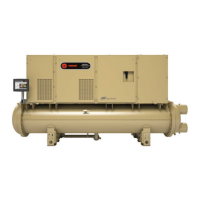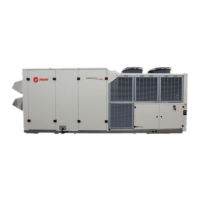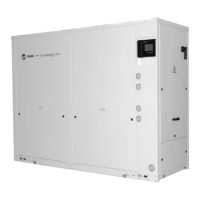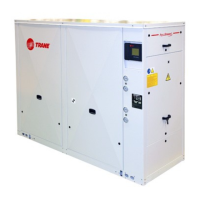98
AC-SVX003A-EN
Diagnostics
General Diagnostics Information
Diagnostic Name and Source: Name of Diagnostic and
its source. The variable “x” in the AFD diagnostic name
string denotes a circuit designator (either 1 or 2). With that
exception, this is the exact text used in the User Interface
and/or Service Tool displays.
Affects Target: Defines the "target" or what is affected by
the diagnostic. Usually either the entire Chiller, or a
particular Circuit or Compressor is affected by the
diagnostic (the same one as the source), but in special
cases functions are modified or disabled by the diagnostic.
"None" implies that there is no direct affect to the chiller,
sub components or functional operation.
Design Note: Functions that are affected by a diagnostic
are simply reported as "chiller or circuit x" targets in
Tracer® TU and on the Alarms page of the AdaptiView™
display, even though only a specific function and not the
entire circuit or chiller would be effected.
Severity: Defines the severity of the above effect.
Immediate means immediate shutdown of the affected
portion, Normal means normal or friendly shutdown of the
affected portion, Special Action means a special action or
mode of operation (limp along) is invoked, but without
shutdown, and Info means an Informational Note or
Warning is generated. Design Note: Tracer TU does not
support display of "Special Action", on its Diagnostics
pages, so that if a diagnostic has a special action defined in
the table below, it will be displayed only as "Informational
Warning" as long as no circuit or chiller shutdown results. If
there is a shutdown and special action defined in the table,
then the Tracer TU Diagnostics Page display will indicate
the shutdown type only.
Persistence: Defines whether or not the diagnostic and its
effects are to be manually reset (Latched), or can be either
manually or automatically reset when and if the condition
returns to normal (Nonlatched).
Active Modes [Inactive Modes]: States the modes or
periods of operation that the diagnostic is active in and, as
necessary, those modes or periods that it is specifically
"not active" in as an exception to the active modes. The
inactive modes are enclosed in brackets, [ ]. Note that the
modes used in this column are internal and not generally
annunciated to any of the formal mode displays.
Criteria: Quantitatively defines the criteria used in
generating the diagnostic and, if nonlatching, the criteria for
auto reset.
Reset Level: Defines the lowest level of manual diagnostic
reset command which can clear the diagnostic. The
manual diagnostic reset levels in order of priority are: Local
or Remote. For example, a diagnostic that has a reset level
of Remote, can be reset by either a remote diagnostic reset
command or by a local diagnostic reset command.
AFD Diagnostics
Table 29. Diagnostics — AFD
Diagnostic
Name and
Source
Affects
Target
Severity
Persistence
Active Modes
[Inactive
Modes]
Criteria
Reset
Level
Controller
AFD
(a)
AFD Bus Over
Voltage - xA
Cprsr
Immediate NonLatch
Momentary
NonLatch
All
TR200 Alarm Code (A7), Alarm Word: 1,
Bit: 11, Dec: 2048
If the intermediate circuit voltage exceeds
the limit, the adjustable frequency drive
trips after a time.
Remote
AFD Bus Under
Voltage - xA
Cprsr
Immediate NonLatch
Momentary
NonLatch
All
TR200 Alarm Code (A8), Alarm Word: 1,
Bit: 10, Dec: 1024
If the intermediate circuit voltage (DC)
drops below the undervoltage limit, the
adjustable frequency drive checks if a 24 V
backup supply is connected. If no 24 V
backup supply is connected, the
adjustable frequency drive trips after a
fixed time delay.
Remote
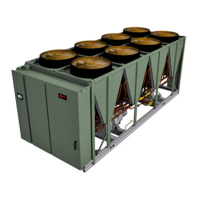
